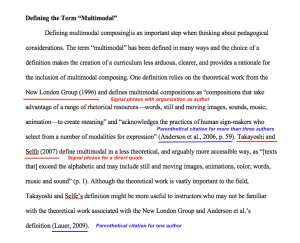12.6: APA Citations- In-Text Citations
- Page ID
- 224348
\( \newcommand{\vecs}[1]{\overset { \scriptstyle \rightharpoonup} {\mathbf{#1}} } \)
\( \newcommand{\vecd}[1]{\overset{-\!-\!\rightharpoonup}{\vphantom{a}\smash {#1}}} \)
\( \newcommand{\id}{\mathrm{id}}\) \( \newcommand{\Span}{\mathrm{span}}\)
( \newcommand{\kernel}{\mathrm{null}\,}\) \( \newcommand{\range}{\mathrm{range}\,}\)
\( \newcommand{\RealPart}{\mathrm{Re}}\) \( \newcommand{\ImaginaryPart}{\mathrm{Im}}\)
\( \newcommand{\Argument}{\mathrm{Arg}}\) \( \newcommand{\norm}[1]{\| #1 \|}\)
\( \newcommand{\inner}[2]{\langle #1, #2 \rangle}\)
\( \newcommand{\Span}{\mathrm{span}}\)
\( \newcommand{\id}{\mathrm{id}}\)
\( \newcommand{\Span}{\mathrm{span}}\)
\( \newcommand{\kernel}{\mathrm{null}\,}\)
\( \newcommand{\range}{\mathrm{range}\,}\)
\( \newcommand{\RealPart}{\mathrm{Re}}\)
\( \newcommand{\ImaginaryPart}{\mathrm{Im}}\)
\( \newcommand{\Argument}{\mathrm{Arg}}\)
\( \newcommand{\norm}[1]{\| #1 \|}\)
\( \newcommand{\inner}[2]{\langle #1, #2 \rangle}\)
\( \newcommand{\Span}{\mathrm{span}}\) \( \newcommand{\AA}{\unicode[.8,0]{x212B}}\)
\( \newcommand{\vectorA}[1]{\vec{#1}} % arrow\)
\( \newcommand{\vectorAt}[1]{\vec{\text{#1}}} % arrow\)
\( \newcommand{\vectorB}[1]{\overset { \scriptstyle \rightharpoonup} {\mathbf{#1}} } \)
\( \newcommand{\vectorC}[1]{\textbf{#1}} \)
\( \newcommand{\vectorD}[1]{\overrightarrow{#1}} \)
\( \newcommand{\vectorDt}[1]{\overrightarrow{\text{#1}}} \)
\( \newcommand{\vectE}[1]{\overset{-\!-\!\rightharpoonup}{\vphantom{a}\smash{\mathbf {#1}}}} \)
\( \newcommand{\vecs}[1]{\overset { \scriptstyle \rightharpoonup} {\mathbf{#1}} } \)
\( \newcommand{\vecd}[1]{\overset{-\!-\!\rightharpoonup}{\vphantom{a}\smash {#1}}} \)
The purpose of this section is to provide you with information and examples pertaining to APA style in-text citations. It begins with parenthetical citations (those that use parentheses to denote citations in the text), moves into signal phrases citations (those that cite information within sentences), and concludes with a visual annotated example of in-text citations.
Parenthetical Citations
When including parenthetical citations, be sure to place a comma between information and place a period after the parenthesis.
If there is an author, then place the author’s last name and year of publication inside:
- Example of a parenthetical citation with an author: (Smith, 2010).
If there is no author, then place the source title (with quotation marks and title caps) and the year inside:
- Example of a parenthetical citation with no author: (“Cats are Great,” 2011).
When citing two or more authors in a parenthetical citation, use an ampersand (&) in place of the word “and.”
- Example of the use of an ampersand: (Kirchoff & Cook, 2016).
When citing two authors, include both of their names in each citation.
- Example of citing two authors: (DePalma & Alexander, 2015).
When citing three or more authors, use the first author’s last name and “et al.”
- Example of citations with three or more authors: (Anderson et al., 2006).
If you’re directly quoting, then include page numbers
- Example direct quote cited with a parenthetical citation with an author: Multimodal composing offers students opportunities to make meaning and communicate using affordances that “could expand that notion of control beyond words on a page” (Takayoshi & Selfe, 2007, p. 2).
Paraphrased information does not require the use of page numbers
- Example paraphrased information: Some universities have developed laptop programs requiring students to either own or lease laptops (Fried, 2008).
Use semi colons to demonstrate the use of multiple authors. This is especially useful when many authors have similar arguments or have found similar results.
- Example of paraphrased information from multiple authors:Education embraced emotion research from psychology and argued that emotion affects learning (Efklides & Volet, 2005; Pekrun, 2006; Pekrun, Frenzel, & Peery, 2007)
Signal Phrase Citations
Using signal phrases to cite information means that you add the citation to your sentence(s). This also means that you do not need an additional parenthetical citation.
Insert the author’s name and year into your sentence to act as a signal phrase.
- Example of paraphrased information using a signal phrase: Sheppard (2009) argues that there is a need for students to adapt to this changing digital landscape.
- Example of a direct quote using a signal phrase: Moran (2003) argues that some teachers think “technology is good and that it will bring good” (p. 344).
Do not use an ampersand (&) in signal phrases; instead, use the word “and.”
- Example using a signal phrase for two authors: Kirchoff and Cook (2016) argue that some overlook the importance of teaching basic computer literacy skills when teaching multimodal composition.
Example of APA Style In-Text Citations

For more information about APA style in-text citations, please visit the OWL of Purdue:
- Click here for information about general layout and formatting in an APA paper.
- Click here for information about in-text citations, which look quite different than what we see in MLA.
- this page will help you understand how to introduce authors/sources in APA, which, again, looks different from MLA
- Click here for information about APA formatted References, particularly electronic sources (which are what we often use in research projects.
“12.6 APA Citations: In-Text Citations” has been edited by Linda Gannon and is licensed under CC BY-NC-SA 4.0 / A derivative from the original work by Melanie Gagich.

